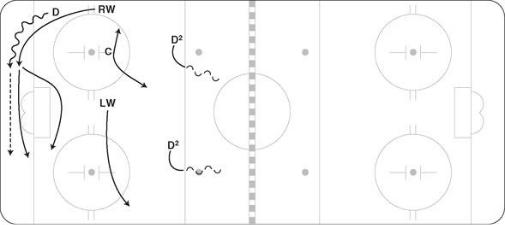
- •Foreword
- •Preface
- •Key to Diagrams
- •Reading Pressure and Options
- •Reacting to Support the Breakout
- •Breakout Plays
- •Control Breakouts
- •Counters
- •Regroups
- •Dump-In Entries
- •Mid-Ice Entries
- •Wide-Lane Drives
- •The Funnel
- •Two-on-One Attacks
- •Two-on-Two Attacks
- •Three-on-Two Attacks
- •Offsides
- •Activating Defense Into Offensive Zone Entries
- •Cycling
- •Playing Behind the Net
- •Stretching the Zone: Low-High Plays
- •Activating Defense in the Offensive Zone
- •Attack Zone Plays
- •Power-Play Breakouts
- •Gaining and Maintaining Possession off the Entry
- •Zone Setup
- •Five-on-Three Power Play
- •Four-on-Three Power Play
- •Forechecking Systems
- •Neutral Zone Forechecking
- •Neutral Zone Forechecking Systems
- •Neutral Zone Backchecking
- •Neutral Zone Backchecking Systems
- •Handling Defensive Zone Entries
- •Defensive Zone Systems
- •Situational Guidelines for Defensive Zone Coverag
- •Face-Offs and Penalty Kills
- •Forechecking and Penalty Kills
- •Pressuring the Entry
- •Defensive Zone Play
- •Three-on-Five Penalty Kill
- •Three-on-Four Penalty Kill
- •Offensive Zone Face-Offs
- •Neutral Zone Face-Offs
- •Defensive Zone Face-Offs
- •Power-Play Face-Offs
- •Penalty-Kill Face-Offs
- •Special Face-Off Situations
- •Managing Staff
- •Dealing With Officials
- •Adjusting Your Playing Strategy
- •Managing Lines
- •Line Changes
- •Handling the Moment
- •Index
- •About the Authors
Offensive Zone Face-Offs
Offensive zone face-offs are an opportunity to create a scoring chance off a set play. Even if teams lose the draw there are ways to still recover possession and get a shot or chance. Many very sophisticated offensive face-off alignments have been developed over the years, but these alignments cover the basics of offensive zone strategy and provide enough options for teams at every level. You may want to challenge your staff to come up with a set play of their own, but don’t overwhelm your team with too many choices.
Offensive Zone: Won Draws
In the offensive zone, it is critical to win the draw and maintain possession. This section describes various set plays off won draws. A team cannot run all of them every night. It is important to have some variance but like all other systems of play, execution is the key to success. Give the team one play to run for every game and that way they will become used to all the set ups so that later in the year they can adjust on the spur of the moment. Also having variety in plays from game to game keeps the opposition off balance and forces them to have to react in coverage. Make the opposition coches work to figure out what you are running and how to cover that set up.
■ DEEP POSSESSION
For a number of reasons, an offensive center might call a face-off play where he actually helps his opponent win the face-off back toward the corner of the offensive zone (figure 11.1). The tactic behind this deceived loss is to have both wingers positioned and ready to press the defender when he wins the draw back to the corner. This quick and unexpected pressure often turns over the puck and therefore creates its desired effect, which is puck possession and a possible scoring chance or play on the net. Off the turnover, the player with the puck may decide to make a quick play to the net or take the puck behind the net and come out the other side. This strategy should be used only once or twice a game or if the center is struggling to win draws against a particular opponent (this gives that player a strategy to gain possession while losing the draw).
Figure 11.1
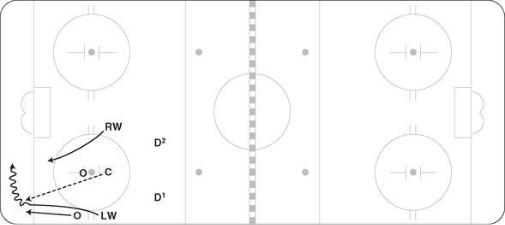
■ INSIDE WINGER DRAW
This face-off starts with the direct intent to win the face-off back to the offensive defenseman. As defending players scramble to front or block the shooting lane of the offensive defenseman, the inside winger RW skates above the circle and out to the side boards (figure 11.2). The center and LW must go hard to the net. The offensive defenseman’s goal is to pull the puck toward the middle of the ice and fake a slapshot. As defenders react to this deception, the defenseman passes the puck laterally to the inside winger, who ends up with a clear shot toward the net through traffic. One variation is for C to drive the net and then push back to get open in the higher slot area. RW can now pass to C.
Figure 11.2

■ ROLL OUT
This offensive face-off alignment works well against teams who press hard towards both defensemen off the faceoff. As the two wingers press the D this Roll Out alignment gives a great pass and shot option. Off a won draw to D1, the two wingers (RW and LW) change positions (figure 11.3). The center drives to the front of the net. D2 drives wide; D1 backs across the the blue line, fakes a shot, and passes to LW, who has found the soft ice (high and lateral from D1). LW now has the option of shooting through traffic or passing to RW or D2.
Figure 11.3
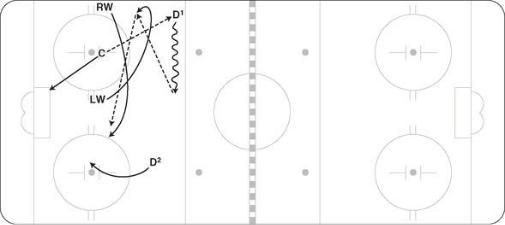
■ END AROUND
Much like the inside-out draw, this alignment uses the inside winger moving to the boards (figure 11.4). Instead of a high option, it creates an opportunity to take the puck to the net low. This face-off also starts with the direct intent to win the face-off back to the offensive defenseman, but the puck doesn’t make it back and lies in the space right behind the center. The inside winger (RW) pulls or draws back toward the boards and in doing so grabs the puck and goes around the pile. As RW moves toward the back of the net, he may either take the puck to the net or pass to C or LW, who attempt to get open.
Figure 11.4
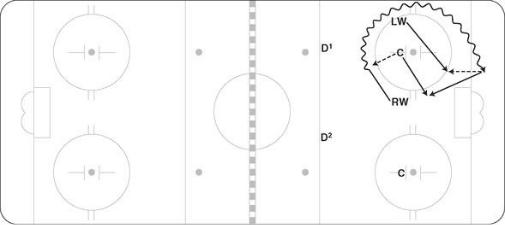
■ OFF-SIDE SHOT
Some face-offs are not always won directly or completely back to the point. When the center senses that he is going to tie-up the opponents stick and and win puck possession with his feet then this simple alignment is effective. In this face-off alignment, the two wingers typically switch positions, unless the boards-side winger is already shooting off his strong side. The center looks to win possession of the puck in the space just slightly behind him (figure 11.5). This allows the boards-side winger to step laterally toward the net and place a quick shot on net through traffic. Sometimes in this situation the center only has to tie up his opponent and leave the puck in the space behind him, which allows the winger to step into the shot.
Figure 11.5

■ SAN JOSE SLIDE
This offensive face-off alignment works well when your team is trying to change things up and is another play that creates a lot of confusion for the defensive team. The center draws the puck back to D1, who moves quickly down the boards as he receives it (figure 11.6). The RW who is on the boards rolls over the top of the circle and sets up on the far post (the back door) taking the defender with him. The LW also goes to the net, giving the defenseman an option to pass to the net at any time. As D1 moves down the boards, C makes it look as if he is going to the net and then moves back a couple of steps into a soft area in the high slot and is open for a one-timer pass from D1. The reason C will be open is that the opposing center will probably go after D1. This movement off the face-off creates confusion in coverage for the defensive team.
Figure 11.6
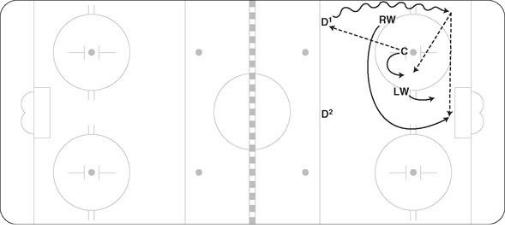
■ FOUR UP
There are times in the game when, like football with little time left on the clock, the team is looking for a simple Hail Mary type play. With a four-up face-off alignment, both wingers are on the inside and one D is down on the boards-side hash marks (figure 11.7). This alignment gives the center a lot of options, making it hard for the defending team to cover. Some defending teams will try to shoot the puck out past the one defenseman on the blue line; guard against that happening by having the inside winger slightly back and in the lane. The four-up face-off allows the center to tap the draw ahead and then pass to one of the two wingers in front; draw the puck back to D1 for a screen shot; or steer the puck to the boards for D2 to shoot or to pass to D1. This alignment is often used when there are seconds left on the clock at the end of periods or the end of games because it results in a quick play on net with numbers in front.
Figure 11.7
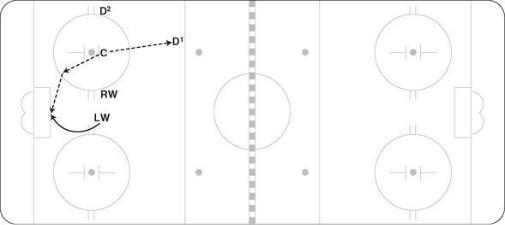
■ TIE-UP FOR POSSESSION
At times, centers just look to create possession of the puck for their team. Possession is often best obtained not by trying to win the puck but rather by blocking or tying up the stick of the opposing center (figure 11.8). If the offensive center can obstruct the stick of the defending center long enough, this allows both offensive wingers to attack the face-off circle to try to win puck possession. This strategy is often referred to as scrambling the puck. There are times in games when one center is dominating the other, so for the player who is constantly losing the draw, tying up the other center increases the odds of your team getting the puck.
Figure 11.8
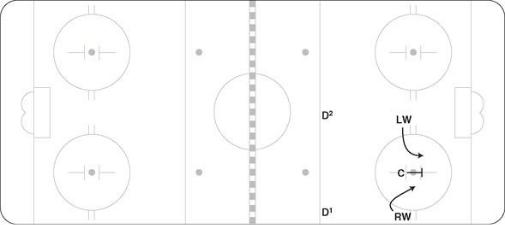
Offensive Zone: Lost Draws
Players should be prepared to win the draw and set up offensive plays as just described, but they should also know what to do when the center loses the draw. If players are ready to react and they understand how they are going to pressure the opposition to recover the puck, they will be much more successful in doing so. Listed here are strategies to regain possession and essentially initiate a forecheck.
■ DOUBLE PRESS
When the C loses the draw, he moves to a high position in the slot (figure 11.9). RW shoots through on the inside of the circle and pressures the defenseman getting the puck. RW must make sure the D doesn’t turn quickly up the strong side. Force the defenseman to go into pressure by pushing him out the wide side. LW also jumps quickly to take away the wide side of the net and any D-to-D passes. D1 is ready to pinch on any pass to the opposing winger on the far boards. D2 stays in mid-ice as the safety
Figure 11.9
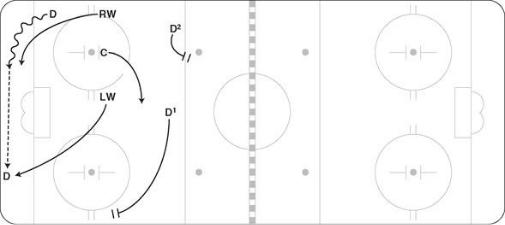
■ 1-2-2 FORCE
On the lost draw, RW pressures hard into the corner, forcing the defenseman around the net or to pass to his partner (figure 11.10). On any D-to-D passes, RW moves across either behind or in front of the net and forces. C is ready to take away plays up the right boards and takes away the mid-ice seam as the puck moves to the wide side. LW takes away the far boards. D1 and D2 stay in midice and react to any passes up the middle.
Figure 11.10
